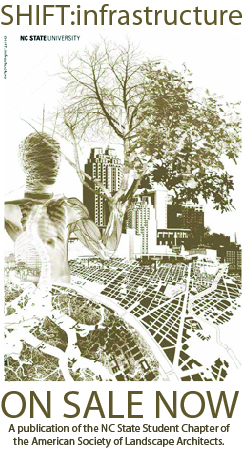Second Place: Active Raleigh
Active Raleigh, Alek Walker and Grant Wylie; North Carolina State University, industrial design and architecture
“When designing functional, attractive, and inviting greenway trails, the small details matter. Elements such as a lighting fixtures, public art, benches, and other amenities help create a unique identity for each greenway trail within the CAG System. ”
– 2014 Capital Area Greenway Planning & Design Guide
OVERVIEW
An effective and enjoyable greenway experience requires a well articulated path, points of reference and information, and nodes or small breakaways for rest and relaxation. We arrived at this consensus through our research of Raleigh’s future greenway development pans, top urban bike paths and greenways in the U.S., and surveyed Raleigh residents. Our proposal is to create a more enjoyable and safer greenway, while providing a stronger collegiate connection, and more ways to enjoy Raleigh’s natural beauty.
Path, Light, Safety
From our surveyed pool of NCSU students and Raleigh residents the most common concern was safety. Because of the greenways often heavily wooded trails and low sun during winter months, a lack of adequate lighting can create unsafe areas and prevent tail use. Our lighting system, designed to emulate that of a tree canopy, would provide sufficient lighting for trails 5-12ft in width and allow for safe and enjoyable trail use. In addition, like that of NCSU’s bluelight emergency system, lights at every 1/10th mile increment would include an emergency button in the event someone using the greenway needed assistance.
Point, Kiosk, Information
With NCSU’s kiosks in need of repair or replacemnt we see this as a key way for the R-Greenway
system to form a stronger connection with both main and centenial campus. By replacing these
kiosks with a more sustainable and maintainable design, the Greenway system will gain a
permanent means of spreading information to active university students. Though designed for
collegiate use, these kiosks could also be implimented throughout the greenway system at any
key point where information needs to be shared.
Node, Shelter, Experience
Though the greenway provides miles of beautiful scenery it lacks the small areas, to rest and
enjoy your surrounding, that many other top ranked greenway systems incorporate. These small shelters provide means for visitors to stop and enjoy their surroundings. This could be a point to rest during a morning bike ride, a place to meet up with a friend, or just a place of refuge when caught in a surprise rain shower. In this way the roofs of these shelters create a connection to the nature of Raleigh Greenway. Built of large metal oak leaves, they create an auditory connection to nature as the rain hits their surface, trickles down towards the center roof opening, and runs along metal rods towards the ground.
![[Walker_Wylie]_navigation_02](https://shiftncsu.files.wordpress.com/2015/03/walker_wylie_navigation_02.jpg?w=116&h=300)



Superb kind of work by the team as on this particular topic people needs more precise information and special attention to it.Thanks a lot.